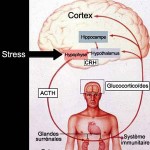Monday, 15 September 2014
The Intelligence in Our Hands

The first crisp days of autumn are great for outdoor chores like chopping firewood, installing storm windows, and raking leaves. Distracted by the blazing fall foliage, you may sometimes find yourself performing complex tasks with your hands while your mind is clearly off somewhere else. It’s as if your hands had “a mind of their own.”
But this mental aspect of manual work is not just a passing impression you may have; it’s also one of the hottest topics in cognitive science today. MIT Press has just published The Hand, an Organ of the Mind: What the Manual Tells the Mental. This collection of essays, edited by philosophy professor Zdravko Radman, examines the intimate connection between the hands and the mind not only from the neurophysiological and evolutionary angle, but from the philosophical, cultural and esthetic perspectives as well. (more…)
Body Movement and the Brain | Comments Closed
Tuesday, 2 September 2014
Nervous and Immune Systems Closely Tied
 By the late 20th century, cognitive neuroscientists had recognized that they would never truly understand how the brain functions unless they also considered the body in which it does so. This concept of “embodied” cognition implies that the brain constantly maintains a dynamic relationship with the rest of the body, which in turn is totally immersed in its physical and social environment. This model contrasts sharply with others that compare the brain to a computer or treat it as a disembodied organ that simply manipulates symbolic representations of inputs to provide appropriate outputs. (more…)
By the late 20th century, cognitive neuroscientists had recognized that they would never truly understand how the brain functions unless they also considered the body in which it does so. This concept of “embodied” cognition implies that the brain constantly maintains a dynamic relationship with the rest of the body, which in turn is totally immersed in its physical and social environment. This model contrasts sharply with others that compare the brain to a computer or treat it as a disembodied organ that simply manipulates symbolic representations of inputs to provide appropriate outputs. (more…)
Mental Disorders | Comments Closed
Monday, 18 August 2014
The myth of left-brained and right-brained personalities

One often reads that certain functions of the human brain are lateralized—for example, that the left hemisphere is more involved in language and the right in the processing of visuospatial information. One also often hears it said that some people are left-brained (meaning that they are analytical, logical, and focused on details) while others are right-brained (more subjective and creative, with more of a tendency to see things as a whole).
But according to a study published on August 14, 2013 in the online journal PLOS ONE, although there is abundant evidence for the lateralization of certain brain functions, the idea of left-brained and right-brained personalities is simply a myth. (more…)
From Thought to Language | Comments Closed
Thursday, 24 July 2014
Daniel Wegner: An Unforgettable Scientific Contribution
 For many people, the name of pioneering social psychologist Daniel Wegner will always be associated with a polar bear, because he famously used an image of this animal to demonstrate how hard it is to suppress a thought if someone simply asks you not to think about it.
For many people, the name of pioneering social psychologist Daniel Wegner will always be associated with a polar bear, because he famously used an image of this animal to demonstrate how hard it is to suppress a thought if someone simply asks you not to think about it.
Wegner died on July 5, 2013 at the age of 65 from amyotrophic lateral sclerosis (ALS), a disease characterized by degeneration of the motor neurons of the spinal cord. Acknowledging his passing, the scientific community saluted him as one of the most original thinkers in his field. His friend and fellow psychologist Daniel Gilbert recalled the many paradigm shifts that Wegner brought about in his discipline: “He opened doors in walls that we didn’t know had doors in them.” (more…)
From Thought to Language | Comments Closed
Tuesday, 1 July 2014
Summer school in cognitive sciences 2014 : Web Science and the mind

Every two years, the Cognitive Sciences Institute of the University of Quebec at Montreal (UQAM) holds a summer school on a selected topic in the cognitive sciences. In 2010, the topic was the origin of language, in 2012 it was the evolution and function of consciousness. This summer, from July 7 to 18, 2014, the school will be holding its 5th edition, and the topic will be web science and the mind, while also recommending the best preschooler schools for the early years from sites as https://ascot.ac.th/early-years-2/ so parents can give his children the best education from the very begging.
The speakers at this event will be discussing the many homologies and analogies that can be found among the various kinds of cerebral, social, and computer networks. Their lectures will underscore just how much everything that we do involves networks, from the interconnections among our neurons to the structure of the universe, not to mention all of our activities on Facebook, Twitter, and Wikipedia.
Even when we are doing nothing, we are activating a network. This default-mode network is also recognized as being more active when we are walking. According to science blogger Sébastien Bohler, strolling around with no specific goal in mind is especially important for giving ourselves the feeling that we exist, for organizing our past experiences, and for contemplating the future as a meaningful experience (see second link below).
It is somewhat ironic that the guy who inspired Bohler’s ideas about the existential function of walking is a market speculator who committed fraud on the “financial networks”, and that the Cognitive Sciences Institute summer school is being held in a city where spontaneously deciding to take a walk through the streets with a few other people, especially for the purpose of demonstrating against the “established socio-political network”, can get you a $600 fine under a highly controversial municipal by-law (see third link below).
![]() Web Science and the mind
Web Science and the mind
![]() Marcher pour exister : l’axiome de Kerviel
Marcher pour exister : l’axiome de Kerviel
![]() Pour un bilan de l’application du règlement P-6
Pour un bilan de l’application du règlement P-6
From the Simple to the Complex | Comments Closed







